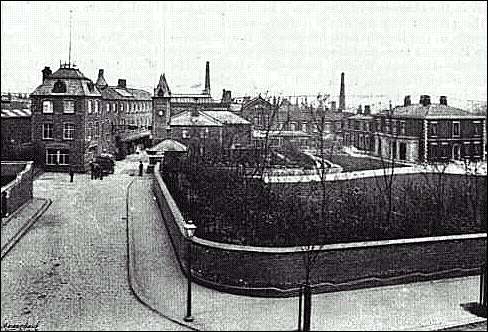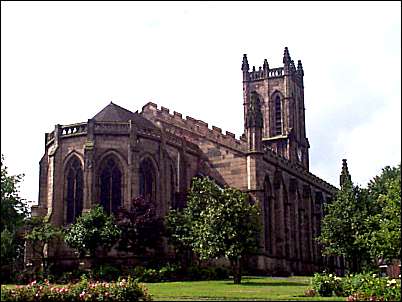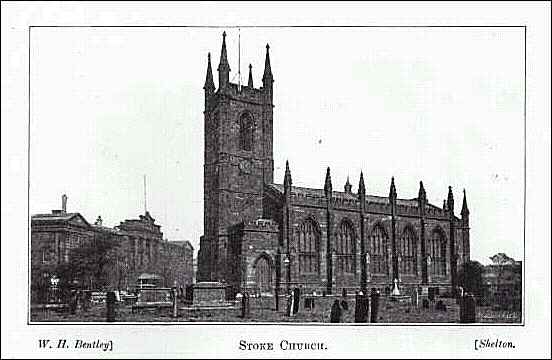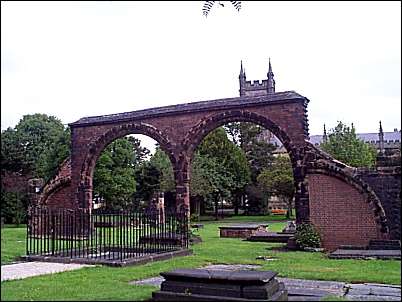|
The year is 1845
the Old Man traveller is long dead
but his now ageing grandson still treads the same old paths between
Hanley and Stoke. The fields are much the same, but the smoke from Mr Ridgway's Cauldon Place pottery on the canalside hangs in the air. He
watched a coal-laden canal boat heading for the hills. A short canal
extension had been built to Leek, so that the town could be supplied
with coal. He had never been to Leek, but he had heard the journey was
difficult especially in winter. As he walked through the Glebe land at
Winton's Wood, he reflected that if the Rector of Stoke created any more
new parishes, there would be nothing left.
|

The
Cauldon Place works - founded c.1802 by Job Ridgway
This picture from "A
descriptive account of The Potteries (illustrated)"
a 1893 advertising and trade journal. |
It had all begun in 1807 when what was
proudly hailed as one of the largest parishes in the country, lost
Burslem, Newcastle-under-Lyme and some other out-lying areas. Since then
as the population grew, new parishes had been created at Hartshill,
Penkhull and nearer to home, St Mark's at Shelton back up the hill. He
had heard that Etruria was next. These were just the nearer ones, for
there were others at Fenton and Longton. Robert Peel had much to answer
for with his New Churches Acts, but there again he supposed that all
these immigrants from the countryside needed spiritual guidance as well
as work and houses.

St Mark's at Shelton
Great Reform Act:
The Potteries townships were now
amalgamated into the new Parliamentary Borough of Stoke-upon-Trent as
a result of the Great Reform Act of 1832, with a new Town Hall opposite
the Church, a Member of Parliament (old Josiah's son), and a population
of sixty five thousand. Speaking of the Church, he reflected that Stoke
Parish had not fared too badly, as the new St Peter's Church had at last
been finished in 1826. It had been sad to see the old Church pulled
down, but a piece of the oldest part had been saved and stood in the new
churchyard near Josiah Wedgwood's vault; he had died in1795. The Fowlea
Brook had been culverted and covered over to allow Glebe Street to be
laid out - and very smart it was looking. He supposed it was all
inevitable - in the name of progress!

St. Peter's in
about 1893

Ruins of earlier church
(Arches) in the
grounds of Parish Church of St. Peter Ad Vincula
The railed area
in front of the arches is
the tomb of Josiah Wedgwood I

These houses were built
in 1838 are situated on the north side of Brook Street (off Glebe
Street) which crosses the line of the culverted Fowlea Brook - hence the
name Brook Street.
The railway & Winton
Square:
But the one thing he never failed to do
during his journey, was to stop at the new railway line to see the steam
locomotives and carriages. As he stood fascinated, behind the gated
crossing, he pondered that he had seen the pottery manufactories
changed beyond recognition by steam power, and wondered how the canals
could compete with steam locomotives which could travel at twenty miles
an hour.
He looked along the new road towards the new railway station, with the
new hotel across the square. Winton Square they were going to call it,
and the hotel was going to be the North Stafford -good thing not
everything is "new", he thought. At the other end of Station Road,
where the railway crossed Rykeneld Street by means of a wide iron
bridge, the road to Stoke no longer went up the hill towards Hartshill,
but rather along a new straight road on the level, across King's
Meadow - more Glebe land - which was now called Liverpool Road;
the old road sensibly enough would be called Shelton Old Road.
Walking back towards Hanley, he took the
new Turnpike across Winton's Field. Leek Road they called it, straight
as an arrow to Bucknall and beyond. He had watched it being built, and
had seen the latest construction methods brought about by the ideas
of Metcalf, Macadam and Telford. The most significant innovation
was not the layers of crushed stone that made up the foundation, but
the final water-bound topping of small gravel to fill the voids and
provide a smooth surface for horses and carts. People called it a
macadam road, a fitting tribute to the man who had persuaded the
authorities to adopt it. However sett-paving or cobbling was still the
preferred method of road surfacing for town streets.
Chartists:
He paused for thought and looked
across to Winton's Wood behind the new hotel and recalled the scenes
three years ago, when a large body of Chartists had met there, before
marching in procession to Longton and on to the Mear (Meir), to meet
the Irish radical Feargus O'Connor who was on his way back to Manchester
after addressing Chartist meetings in Nottingham and Derby.
The Hanley and Shelton Political Union had been formed in 1838,
and he recalled a meeting in Hanley the same year. They were
heady days, with popular support for improved social conditions
and electoral change which the Reform Act had failed to deliver. Later
the same year Dragoons and Infantry had confronted Chartist rioters
in Burslem, when shots were fired with fatal results and the riot
was dispersed. In the aftermath, 54 men were sentenced to transportation
- 11 for life. The Chartist movement had largely declined, and changes
were on the way.
 on
Chartism on
Chartism
Housing development:
Already a row of houses was under
construction near the railway, to be called Winton Terrace and there was
also the start of building along the new Leek Road. He looked across to
the east, beyond the Trent, and saw the new Manor House at Little
Fenton, built by Philip Broade JP. The fields to the north, towards
Botslow would pass into history as "Squire Broade's", where
succeeding generations would take Sunday afternoon walks at least
until the latter part of the 20th Century.
As he trudged homewards in the dusk, he wondered when the new
gas street lighting would reach Leek Road. The 1826 Gas Works at Lower
Bedford Street in Shelton had been a remarkable success with street
lighting in Hanley and Stoke. There seemed to be no limit to these new
ideas and he wondered where it would all end. At the present rate, the
Glebe land of Stoke Parish would be swallowed up by new enterprises. He
hoped the Rector would keep enough to live on, and not be obliged to
seek Queen Anne's Bounty as an "Impoverished Clergyman".
  
next: St. Jude's church and town
previous: canals
|
![]()
![]()
![]()